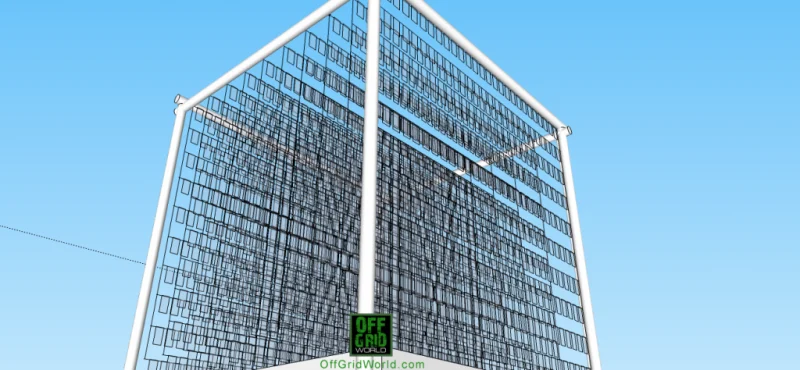Food production systems of the future will need to maximize available space in ways that traditional farming can’t. I’ve designed this concept with that in mind: an ultra high yield solar powered vertical aquaponics system that maximizes crop yield per square foot.
I’ve made this concept available under an OPEN SOURCE license for anyone to improve upon, modify, and use for producing organically grown food in their local area. The ultimate goal of building and improving this system is getting as close as possible to an annual crop yield of 1 Million pounds of organically grown food per acre.

EXPERIMENTAL ULTRA HIGH YIELD SOLAR POWERED VERTICAL AQUAPONICS SYSTEM
UP TO 20 TIMES THE CROP YIELD PER SQUARE FOOT (or more): This system could theoretically produce 20 times or more annual food yield per square foot of land than flat farming row crops.
100sqft FOOTPRINT: Each module covers a horizontal area of only 100 square feet, which means almost anyone can build one of these modules in their back yard without taking up much space at all.
2000 square foot VERTICAL GROW AREA: Each module has a vertical grow area of 2000 square feet.


VERTICAL AQUAPONICS SYSTEM: This system is a vertical aquaponics/aeroponics hybrid system used to grow fresh fruits, veggies, and fish. The water is circulated using a pump in the ground tank, up through the piping, and down over the planters. The water is filtered through the plants, and the fish waste provides the needed nutrients for the plants to grow.

5200 PLANTERS: The system can fit up to 5200 plants per unit (depending on the plant and spacing).

ULTRA HIGH-DENSITY VERTICAL GROWING: Growing vertically allows you to grow more plants per square foot than traditional growing. The unit stands 10 feet tall and we reduce the amount of space between plants to increase the number of plants per square foot vertically and horizontally.
GROW POCKETS & CUPS: (experimental) It uses a hanging vertical pocket/cup system that practically removes the need for growth medium. In a sense it’s a combination of aeroponics and hydroponics, except the watering/filter system is natural and there is no rocks, gravel, or clay grow media to weigh down the system.
SCALABILITY: A large part of making this system work is the ability to scale the system up in order to produce even more food. Ultimately, the goal is 1 million pounds of organically grown food per acre.

MAXIMUM SUNLIGHT: Plants need sunlight, water, and nutrients to grow. This system is designed to provide all 3 in a system with a tiny, 100 square foot footprint.
24V SOLAR POWER SYSTEM: One 250 Watt solar panel will power a single water pump and charge a 24V battery system.
YEAR-ROUND GROWING: The system is designed to be covered with clear plastic sheeting during winter months, converting the system itself into a greenhouse.

OPEN SOURCE: The design will be released to the public under a Creative Commons OPEN SOURCE share and share alike non-commercial license.
 I’m Open Sourcing my design so others (universities, educational institutions, companies, farmers, growers and individuals) can use the system to help increase their yield, modify the design, improve on the design, and or use it to produce crops for commercial sale. The only thing you CAN’T do with my design is sell the design itself or patent it. Since it’s been released under a creative commons share and share alike license, anyone who uses the design MUST make the design available for everyone to use under the same license, or they break the license agreement.
I’m Open Sourcing my design so others (universities, educational institutions, companies, farmers, growers and individuals) can use the system to help increase their yield, modify the design, improve on the design, and or use it to produce crops for commercial sale. The only thing you CAN’T do with my design is sell the design itself or patent it. Since it’s been released under a creative commons share and share alike license, anyone who uses the design MUST make the design available for everyone to use under the same license, or they break the license agreement.
PROJECTED SINGLE MODULE YIELD: (YEAR ROUND GROWING = 4 Harvests) Each module can grow up to 5200 Plants Per Unit/Per Harvest. Yield will be determined in large part by the types of crops grown in the system.
This system is experimental and the first system will dictate the specs and total crop yield after the first harvest. The project will last a full year (approximately 4 harvests to give us an idea of average yield going forward into the future.)

2250 GALLON IN GROUND GROW TANK/POND: The fish grow tank/pond is 2250 gallons. Each tank can hold 1 fish per 2 gallons. That’s 1125 fish, at 1.5 pounds average harvest size. That equates to 1687.5 pounds of fish.
(NOTE: We’d also like to design a portable unit which has an above ground tank, however the costs for the tank, nearly doubles the entire system cost.)
GROWING LOCAL: Anyone can set one of these systems up in their local community and grow food for themselves and their community, or start a business selling organic food.
You could also simply build one in your backyard and grow your own food.
***
This work is licensed under a Creative Commons Attribution-NonCommercial-ShareAlike 3.0 Unported License.



yosoykang
Friday 10th of April 2020
has anyone tried this? Eric - would love to connect with you to discuss details
Specialist vs Generalist: The Future of Business | Spreading Thought
Thursday 17th of April 2014
[…] to that the advent of personalized power, advanced efficiency technologies, and vertical aquaponics, and you have a perfect recipe for unemployment disaster if you’re in 90% of today’s […]
1andreasse
Saturday 8th of February 2014
Hmmm, I might actually try to build one. Who s behind this idea? :) I have blueprints for smaller systems, but would be nice to have blueprints for this one, schematics or anything. So would be nice to take to the guys behind this idea, to see how far they have come.
Off Grid World
Friday 6th of December 2013
Not really expensive at all. The prototype would be the most expensive part of the system. However once the first unit is built, and experiments are performed, the cost for subsequent units will decrease.
Soatmos
Wednesday 16th of October 2019
I'm trying to figure out which "cups" are used. Is it the small hydroponic cups used in hydro and aeroponics? If there isn't a medium is it assumed that the seeds turn into seedlings elsewhere? If so, planting requires any medium used for said seedlings to be removed 1st. Are the fish harvested 4 times per year also? If so, are you repurchising the fish every quarter, or are they supposed to just repopulate at exactly the same amount over time? I have so many questions. This design doesn't seem to have many details to it. At least not from what I saw. What material is used for the enormous fish aquarium? How often is water needing to be added to the aquarium? Is a heat source needed in certain climates in the winter (such as midwest)? Is PVC used in the construction of the system?
designkit1
Thursday 6th of March 2014
I will like to build one of this systems, I have plenty of space300ft*60ft. Can I get the files? Thanks
sunnyarky
Monday 30th of September 2013
interesting, but so expensive to imply